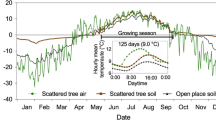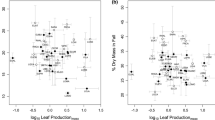Abstract
The elevational range of the alpine cushion plant Laretia acaulis (Apiaceae) comprises a cold upper extreme and a dry lower extreme. For this species, we predict reduced growth and increased non-structural carbohydrate (NSC) concentrations (i.e. carbon sink limitation) at both elevational extremes. In a facilitative interaction, these cushions harbor other plant species (beneficiaries). Such interactions appear to reduce reproduction in other cushion species, but not in L. acaulis. However, vegetative effects may be more important in this long-lived species and may be stronger under marginal conditions. We studied growth and NSC concentrations in leaves and stems of L. acaulis collected from cushions along its full elevational range in the Andes of Central Chile. NSC concentrations were lowest and cushions were smaller and much less abundant at the highest elevation. At the lowest elevation, NSC concentrations and cushion sizes were similar to those of intermediate elevations but cushions were somewhat less abundant. NSC concentrations and growth did not change with beneficiary cover at any elevation. Lower NSC concentrations at the upper extreme contradict the sink-limitation hypothesis and may indicate that a lack of warmth is not limiting growth at high-elevation. At the lower extreme, carbon gain and growth do not appear more limiting than at intermediate elevations. The lower population density at both extremes suggests that the regeneration niche exerts important limitations to this species’ distribution. The lack of an effect of beneficiaries on reproduction and vegetative performance suggests that the interaction between L. acaulis and its beneficiaries is probably commensalistic.




Similar content being viewed by others
References
Adams HD et al (2013) Nonstructural leaf carbohydrate dynamics of Pinus edulis during drought-induced tree mortality reveal role for carbon metabolism in mortality mechanism. New Phytol 197:1142–1151
Al Hayek P, Touzard B, Le Bagousse-Pinguet Y, Michalet R (2014) Phenotypic differentiation within a foundation grass species correlates with species richness in a subalpine community. Oecologia 176(2):533–544
Armesto JA, Arroyo MTK, Villagrán C (1980) Altitudinal distribution, cover and size structure of umbelliferous cushion plants in the high Andes of central Chile. Acta Oecol 1:327–332
Arroyo MTK, Armesto JA, Villagran C (1981) Plant phenological patterns in the high Andean Cordillera of central Chile. J Ecol 69:205–223
Aubert S, Boucher F, Lavergne S, Renaud J, Choler P (2014) 1914–2014: a revised worldwide catalogue of cushion plants 100 years after Hauri and Schröter. Alp Bot 124(1):59–70
Bates D, Maechler M, Bolker B, Walker S (2014) Package lme4: Linear mixed-effects models using Eigen and S4 R package version 1.0-5
Billings W, Mooney H (1968) The ecology of arctic and alpine plants. Biol Rev 43:481–529
Bonanomi G, Stinca A, Chirico GB, Ciaschetti G, Saracino A, Incerti G (2016) Cushion plant morphology controls biogenic capability and facilitation effects of Silene acaulis along an elevation gradient. Funct Ecol 30:1216–1226
Cavieres LA, Arroyo MTK (1999) Tasa de enfriamiento adiabático del aire en el valle del río Molina, provincia de Santiago, Chile central (33 S). Revista Geográfica de Chile Terra Australis 44:79–86
Cavieres LA, Badano EI, Sierra-Almeida A, Gómez-González S, Molina-Montenegro M (2006) Positive interactions between alpine plant species and the nurse cushion plant Laretia acaulis do not increase with elevation in the Andes of central Chile. New Phytol 169:59–69
Cavieres LA, Badano EI, Sierra-Almeida A, Molina-Montenegro M (2007) Microclimatic modifications of cushion plants and their consequences for seedling survival of native and non-native herbaceous species in the high Andes of central Chile. Arct Antarct Alp Res 39:229–236
Cavieres LA et al (2014) Facilitative plant interactions and climate simultaneously drive alpine plant diversity. Ecol Lett 17:193–202
Cavieres LA, Hernández-Fuentes C, Sierra-Almeida A, Kikvidze Z (2016) Facilitation among plants as an insurance policy for diversity in Alpine communities. Funct Ecol 30:52–59
Cranston BH, Callaway RM, Monks A, Dickinson KJ (2012) Gender and abiotic stress affect community-scale intensity of facilitation and its costs. J Ecol 100:915–922
Di Castri F, Hajek E (1976) Bioclimatología de Chile. Ediciones de la Pontificia Universidad Católica de Chile, Santiago
Fajardo A, Piper FI (2014) An experimental approach to explain the southern Andes elevational treeline. Am J Bot 101:788–795
Fajardo A, Piper FI, Pfund L, Körner C, Hoch G (2012) Variation of mobile carbon reserves in trees at the alpine treeline ecotone is under environmental control. New Phytol 195:794–802
Fick WH, Nolte DL (1986) Field collection techniques for total nonstructural carbohydrate analysis of plant storage organs. Trans Kans Acad Sci 89:40–44
Fox J et al. (2011) Package car: Companion to applied regression, 2.0–25 edn. Sage. http://www.r-project.org/
Galvez DA, Landhäusser S, Tyree M (2013) Low root reserve accumulation during drought may lead to winter mortality in poplar seedlings. New Phytol 198:139–148
García MC, Bader MY, Cavieres LA (2016) Facilitation consequences for reproduction of the benefactor cushion plant Laretia acaulis along an elevational gradient: costs or benefits? Oikos 125:434–442
Gibson N, Kirkpatrick JB (1985) A comparison of the cushion plant communities of New Zealand and Tasmania. N Z J Bot 23:549–566
Giraudoux P (2011) pgirmess: Data analysis in ecology. R package version 1.5. 1
Hager J, Faggi AM (1990) Observaciones sobre distribución y microclima de cojines enanos de la isla de Creta y del noroeste de la Patagonia. Parodiana 6:109–127
Halloy SRP (2002) Variations in community structure and growth rates of high-Andean plants with climatic fluctuations. In: Körner C, Spehn EM (eds) Mountain biodiversity. A global assessment. Taylor & Francis, Parthenon, London, pp 225–238
Hauri H (1913) Anabasis aretioides Moq. et Coss., eine Polsterpflanze der algerischen Sahara. Mit einem Anhang, die Kenntnis der Angiospermenpolsterpflanzen überhaupt betreffend. J Ecol 1:118–121
Hoch G (2015) Carbon reserves as indicators for carbon limitation in trees. In: Lüttge U, Beyschlag W (eds) Progress in botany, vol 76. Springer, Berlin, pp 321–346
Hoch G, Körner C (2003) The carbon charging of pines at the climatic treeline: a global comparison. Oecologia 135:10–21
Hoch G, Körner C (2012) Global patterns of mobile carbon stores in trees at the high-elevation tree line. Glob Ecol Biogeogr 21:861–871
Holzapfel C, Mahall BE (1999) Bidirectional facilitation and interference between shrubs and annuals in the Mojave Desert. Ecology 80:1747–1761
Kleier C, Rundel PW (2004) Microsite requirements, population structure and growth of the cushion plant Azorella compacta in the tropical Chilean Andes. Austral Ecol 29:461–470
Klein T, Hoch G, Yakir D, Körner C (2014) Drought stress, growth and nonstructural carbohydrate dynamics of pine trees in a semi-arid forest. Tree Physiol 34:981–992
Körner C (2003) Alpine plant life: functional plant ecology of high mountain ecosystems, 2nd edn. Springer, Berlin
Körner C (2008) Winter crop growth at low temperature may hold the answer for alpine treeline formation. Plant Ecol Divers 1(1):3–11
Körner C (2012) Alpine treelines: functional ecology of the global high elevation tree limits. Springer Science & Business Media, Basel
Kozlowski TT, Pallardy SG (1997) Growth control in woody plants. Academic Press, Cambridge
Landhäusser SM, Lieffers VJ (2003) Seasonal changes in carbohydrate reserves in mature northern Populus tremuloides clones. Trees 17:471–476
Lenth R, Hervé M (2014) lsmeans: Least-Squares Means. R package (version 2.13). http://CRAN.R-project.org/package=lsmeans
Louda SM, Collinge SK (1992) Plant resistance to insect herbivores: a field test of the environmental stress hypothesis. Ecology 73:153–169
Martinez SG (2003) Umbelliferae. In: Kiesling R (ed) Reseña de Flora de San Juan 2. Dicotiledóneas dialipétalas (segunda parte): Oxalidáceas a Umbelíferas, vol 41, Darwiniana, pp 214–234
Michalet R et al (2011) Phenotypic variation in nurse traits and community feedbacks define an alpine community. Ecol Lett 14:433–443
Michalet R et al (2016) Beneficiary feedback effects on alpine cushion benefactors become more negative with increasing cover of graminoids and in dry conditions. Funct Ecol 30(1):79–87
Mitchell PJ, O’Grady AP, Tissue DT, White DA, Ottenschlaeger ML, Pinkard EA (2013) Drought response strategies define the relative contributions of hydraulic dysfunction and carbohydrate depletion during tree mortality. New Phytol 197:862–872
Monson RK, Rosenstiel TN, Forbis TA, Lipson DA, Jaeger CH (2006) Nitrogen and carbon storage in alpine plants. Integr Comp Biol 46:35–48
Piper FI, Cavieres LA, Reyes-Díaz M, Corcuera LJ (2006) Carbon sink limitation and frost tolerance control performance of the tree Kageneckia angustifolia D. Don (Rosaceae) at the treeline in central Chile. Plant Ecol 185:29–39
Piper FI, Viñegla B, Linares JC, Camarero JJ, Cavieres LA, Fajardo A (2016) Mediterranean and temperate treelines are controlled by different environmental drivers. J Ecol 104:691–702
Quentin AG et al (2015) Non-structural carbohydrates in woody plants compared among laboratories. Tree Physiol. doi:10.1093/treephys/tpv073
R Core Team (2013) R: a language and environment for statistical computing. R Foundation for Statistical Computing, Vienna
Ralph CP (1978) Observations on Azorella compacta (Umbelliferae), a tropical Andean cushion plant. Biotropica 10:62–67
Rozzi R, Molina JD, Miranda P (1989) Microclima y periodos de floración en laderas de exposición ecuatorial y polar en los Andes de Chile central. Rev Chil Hist Nat 62:75–84
Sala A, Hoch G (2009) Height-related growth declines in ponderosa pine are not due to carbon limitation. Plant, Cell Environ 32:22–30
Sala A, Woodruff DR, Meinzer FC (2012) Carbon dynamics in trees: feast or famine? Tree Physiol 32:764–775
Schädel C, Blöchl A, Richter A, Hoch G (2009) Short-term dynamics of nonstructural carbohydrates and hemicelluloses in young branches of temperate forest trees during bud break. Tree Physiol 29:901–911
Schöb C et al (2014a) A global analysis of bidirectional interactions in alpine plant communities shows facilitators experiencing strong reciprocal fitness costs. New Phytol 202:95–105
Schöb C, Prieto I, Armas C, Pugnaire FI (2014b) Consequences of facilitation: one plant’s benefit is another plant’s cost. Funct Ecol 28:500–508
Sortibrán L, Verdú M, Valiente-Banuet A (2014) Nurses experience reciprocal fitness benefits from their distantly related facilitated plants. Perspect Plant Ecol Evol Syst 16:228–235
Wiley E, Helliker B (2012) A re-evaluation of carbon storage in trees lends greater support for carbon limitation to growth. New Phytol 195:285–289
Wyka T (1999) Carbohydrate storage and use in an alpine population of the perennial herb, Oxytropis sericea. Oecologia 120:198–208
Acknowledgements
This project was financially supported by MECESUP2, F ICM P05-02 and PFB-023 supporting the Institute of Ecology and Biodiversity (IEB), and the German Academic Exchange Service (DAAD). Support from the ECOBIOSIS working group at the University of Concepcion and the Functional Ecology of Plants laboratory at the University of Oldenburg is much appreciated. We thank Ingeborg Eden who conducted the HPLC analysis for helpful recommendations during NSC extractions. Alicia Marticorena helped with the procedure of sample exportation. Frida Piper provided valuable comments on the manuscript. Finally, we thank Simon Pfanzelt, Erika García Lino and Juan Concha for their help in the field.
Author contribution statement
MCGL and MYB conceived and designed the methodology. MCGL performed the data collection and statistical analysis. All the authors discussed the results. MCGL and MYB wrote the manuscript and other authors provided editorial advice.
Author information
Authors and Affiliations
Corresponding author
Ethics declarations
Conflict of interest
The authors declare that they have no conflict of interest.
Additional information
Communicated by Stephan Hattenschwiler.
Electronic supplementary material
Below is the link to the electronic supplementary material.
Rights and permissions
About this article
Cite this article
García Lino, M.C., Cavieres, L.A., Zotz, G. et al. Carbohydrate reserves in the facilitator cushion plant Laretia acaulis suggest carbon limitation at high elevation and no negative effects of beneficiary plants. Oecologia 183, 997–1006 (2017). https://doi.org/10.1007/s00442-017-3840-5
Received:
Accepted:
Published:
Issue Date:
DOI: https://doi.org/10.1007/s00442-017-3840-5




